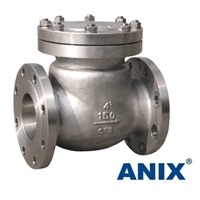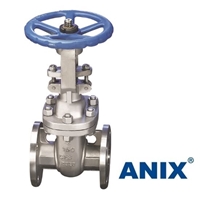By: Lauryn B.

Anix Valve USA is a valve manufacturer based in Houston, Texas. Find out about our wide selection of check valves at https://anixusa.com/check-valve
What is a check valve?
A check valve is only used for a one directional flow that has 2 ports, an inlet and output. They are commonly known as “one way valves” or “non return valves” since it only flows one way. The main purpose for the valve is to make sure it prevents any backflow in the system. It tends to be cheap, effective, and an easy solution to solve a potential issue.
How it works
Check valves depend on pressure for it to work called cracking pressure. It’s the minimum upstream pressure required to open a check valve enough to allow for detectable flow, a small but steady flow that passes through the valve and out the outlet port. Depending on the design of the valve it can close in different ways, such as the back pressure pushing a gate, ball, diaphragm, or disc against the orifice and sealing it. You also have to make sure the valve is facing the right way, it would usually have an arrow on the housing to tell you the direction of the flow direction. If not installed in the right way, it could back up and cause build up pressure which could cause damage.
Materials
The type of materials used are brass, stainless steel, PVC (Polyvinyl Chloride), and Polypropylene (PP). Brass check valves are commonly used for applications that are using air, water, oil, or fuels. Stainless steel is more resistant to corrosion, heat, low temperature and mechanical properties. PVC check valves are used in irrigation and water management systems. Polypropylene check valves are used for water, aggressive media, and liquid food products.

Check valve types
There are different types of check valves, the most common one is the spring loaded in-line check valve. Some other ones are spring loaded y, ball, diaphragm, lift, swing, stop, butterfly, wafer, duckbill and foot valve. We’ll talk about a few to get a better understanding of the different types.
Information about valve types
A spring loaded in-line check valve is common and easy to understand. When the flow goes through the input of the valve, it has enough pressure to push through the cracking pressure and the spring force. It pushes against the disc and allows the flow of the fluid to go on through. When the input pressure is no longer high, the back pressure is then the disc gets pushed back into place and seals the valve shut. This valve prevents pressure surges from happening, and also prevents water hammering from occurring. Some common types of spring loaded are ‘nozzle check valves’ or ‘silent check valves.’
Another one is called the spring loaded y and it's similar to the spring loaded valve. The only difference is that the spring and the disc are more at an angle, creating a y-shape, for its design. A ball is seated next to a spring that is close to the orifice. When the pressure from the fluid exceeds the cracking the pressure then the ball is ejected from its seat and allows the flow to go through. Due to its design, it can be inspected inside and “serviced.” But they are larger and it takes more room when installed into the system.
Here is just a quick rundown of a few other types. Diaphragm check valves are normally open due to self centering diaphragm, which means it doesn't have cracking pressure. The diaphragm has a rubber diaphragm that flexes the inlet pressure to increase. A lift valve has a guided disc that lifts up from the seat allowing the fluid flow through. This one does have a cracking pressure, it is so the disc can be sealed back into its alignment. A swing valve is usually referred to tilting-disc’ check valves. The disc tends to swing open when the inlet pressure is high enough, but when it decreases the disc will swing shut. A stop valve has more of a manual feature. It acts like a normal check valve and can prevent backflow. There is also another mechanism in case for overriding so it can open and close the valve. A butterfly or wafer valve has a hinge and a spring inside. When the pressure builds up, both sides open. But when it decreases, the disc will seal it shut. A duckbill valve lets the fluid go through a soft tube, almost resembling a beak. As the flow goes through, it opens up , but the beak shape flattens stopping from anything from coming through. A foot valve is a check valve with a strainer on the inlet side. They allow the flow to go in one direction and close it off with a spring.





